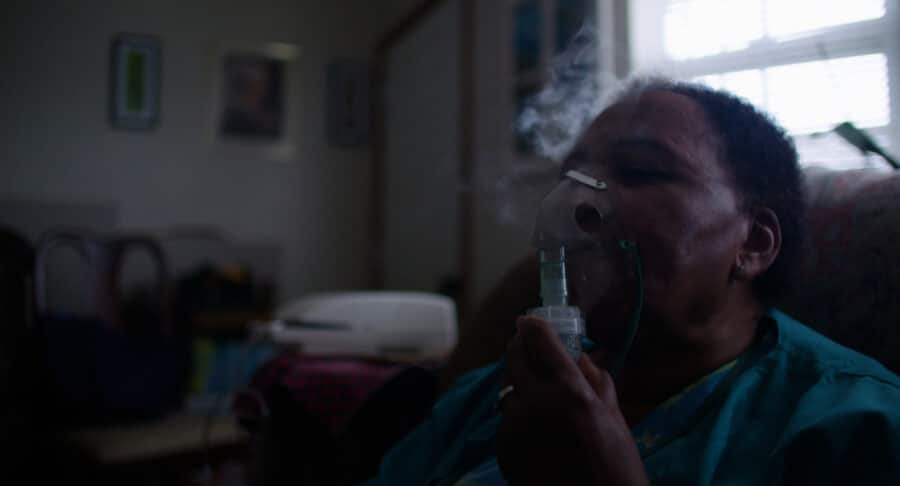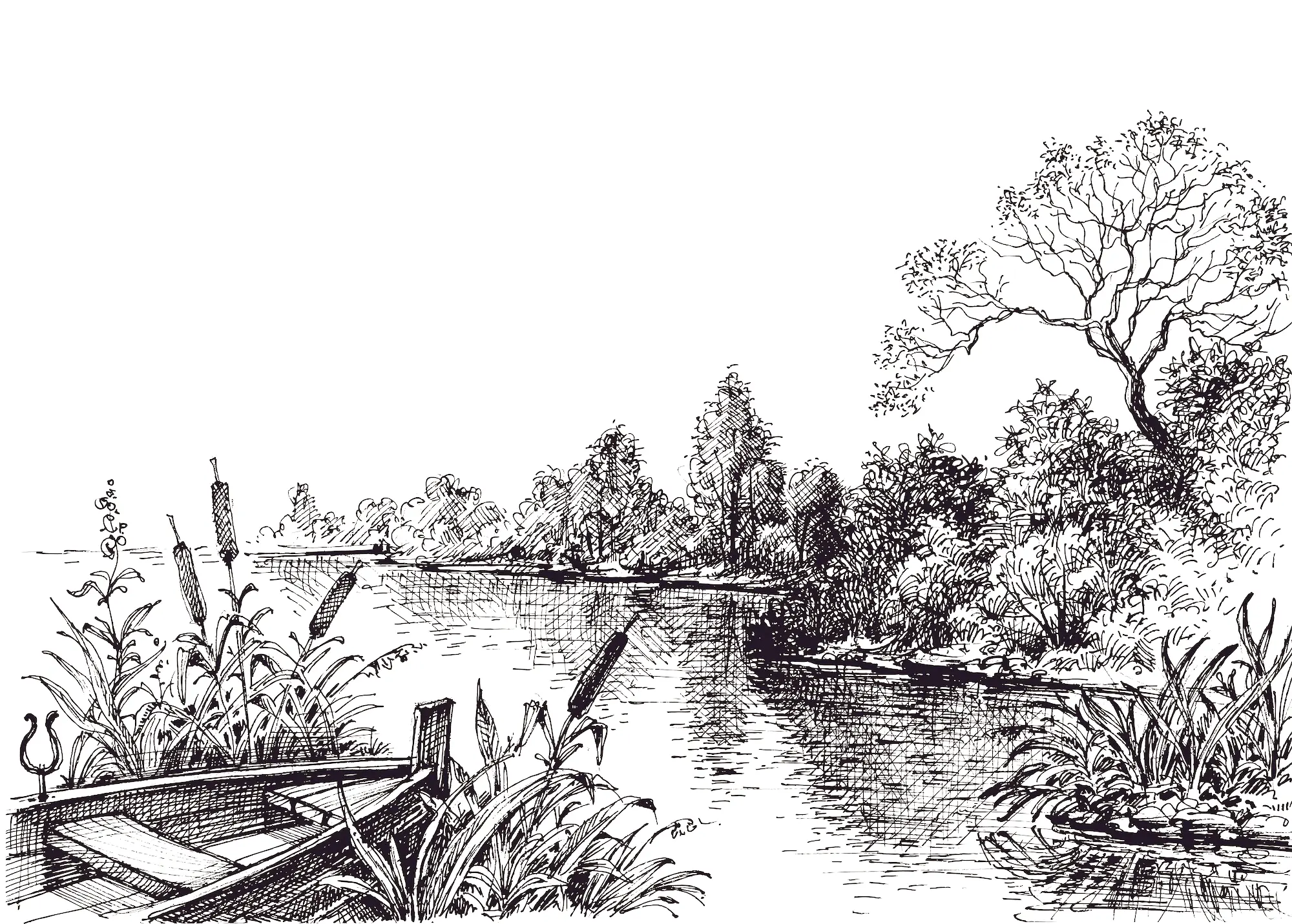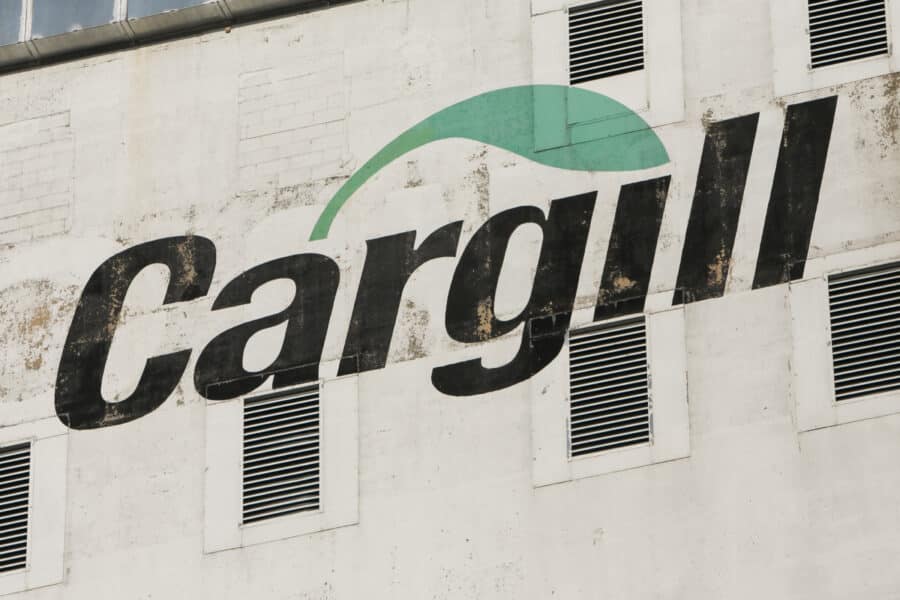Water wells, streams and ponds adjacent to fields spread with municipal sewage sludge have levels of PFAS ‘forever chemicals’ roughly nine times higher than non-adjacent fields, according to Sierra Club test results from dozens of sites in a section of Steuben County.
Nine Times More ‘Forever Chemicals’ Found in Water Near Sludge-Spread Fields
New York State and waste management entities promote the use of sewage sludge as fertilizer, but recent tests show high levels of PFAS pollution in water near sludge-spread fields
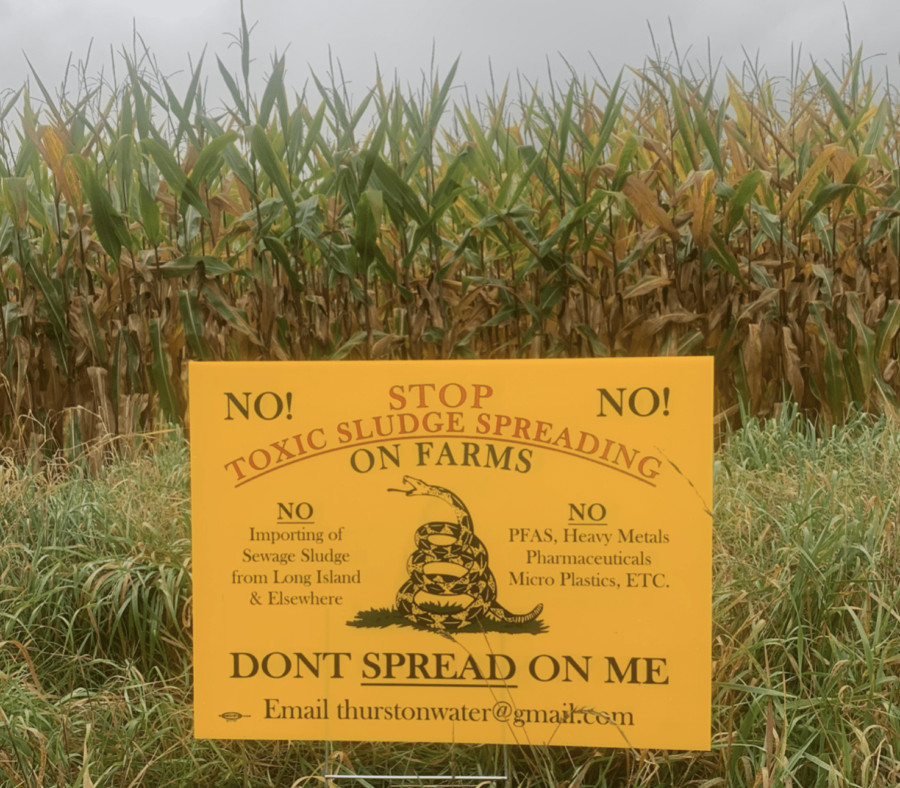

The data was presented on December 20 to the Town Board of Thurston, New York (population 1,248), which recently passed a town law banning the spread of sewage sludge on its fields.
The tests reportedly showed that 46 sites adjacent to spread fields had average PFAS totaling 15.1 parts per trillion, while 37 sites non-adjacent to spread fields averaged 1.7 ppt.
“Based on the findings from 83 samples in the towns of Thurston, Cameron, and Bath,” the Sierra Club said its slideshow report, “we urge the [state Department of Environmental Conservation] to investigate water contamination adjacent to land-spreading and in regions of associated runoff.”
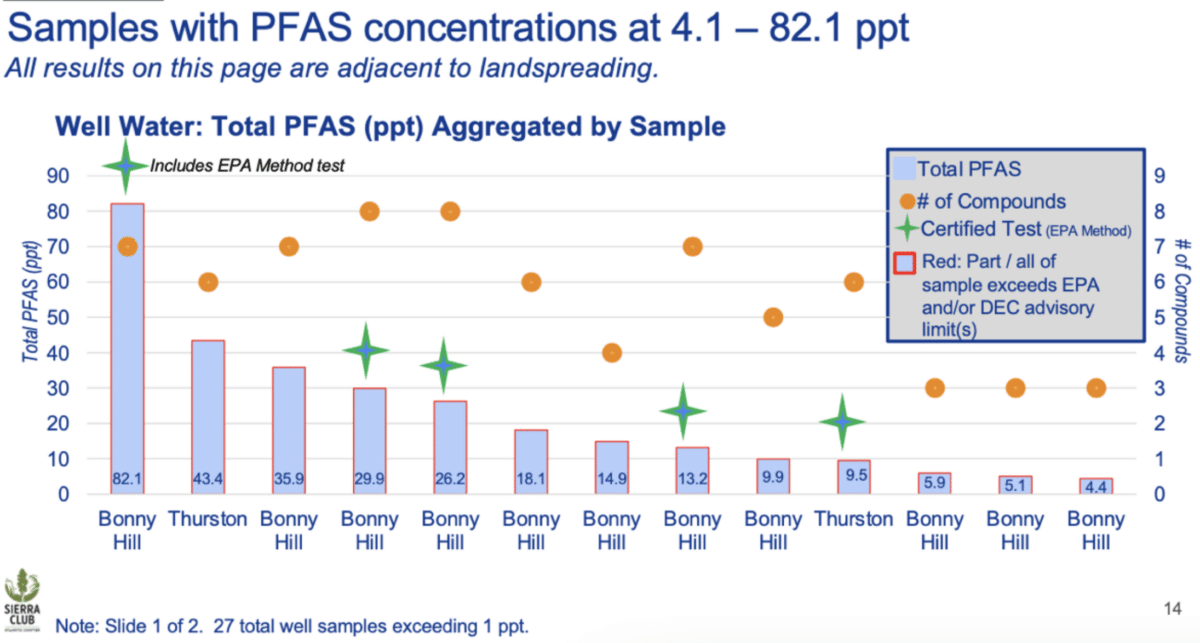
Although other states have found that sewage sludge contains toxic chemicals, including PFAS compounds, that have contaminated crops, cattle and water on farms where it has been spread, the DEC promotes the practice. The agency refers to the sludge as “biosolids” and advocates big increases in its use as fertilizer.

“The premise of our program … is that these materials are beneficial to farms,” the DEC’s Sally Rowland told town officials and Steuben residents in August. “It’s not a waste disposal activity.”
The municipal sewage sludge left over from the wastewater treatment process is a mix of human excrement and industrial wastes. Treatment plants pay to get rid of it.
The Thurston Town Board enacted its ban in October, roughly a year after board members learned that Casella Waste Systems Inc. had quietly bought or leased 2,790 acres from Leo Dickson & Sons Inc. or affiliates. The Dicksons had been spreading sewage sludge in the Bonny Hill area for more than 30 years.
After apologizing for not telling the Thurston board about their plan to assume control and continue the spreading, Casella officials said they intended to add a new source of sludge: the Bay Park wastewater treatment plant on Long Island. The DEC is weighing the company’s application to import from Bay Park.
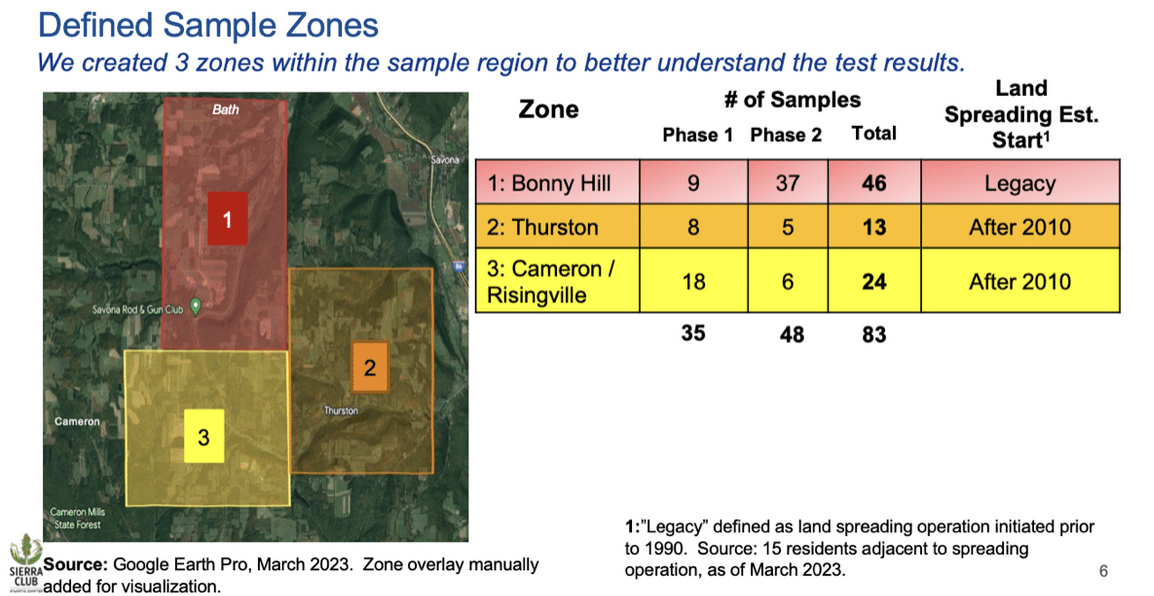
The Thurston board, aware that Maine had banned sludge spreading statewide, encouraged the Sierra Club to test local water sources for PFAS and retained the pro bono environmental law group Earthjustice to help it draft its ban.
Last spring, the Sierra Club hired Illinois-based Cyclopure Labs to analyze samples from 35 sites, including 32 water wells. According to uncertified test results, the five samples with the highest total PFAS were adjacent to Bonny Hill fields that had received sludge since the 1980s.
Casella’s Mary Rayeski, supervisor of the company’s newly named Bonny Hill Organics unit, dismissed the PFAS levels from the springtime tests as “minuscule” and stressed that the findings were uncertified.
This fall the Sierra Club’s Atlantic Chapter arranged for 48 new tests, including 42 more uncertified tests by Cyclopure and six certified tests by Eurofin Labs in Lancaster, Pennsylvania.
The spring and fall results were merged and then analyzed by area (Bonny Hill, Thurston or Risingville/Cameron) and source (well, stream or pond). The findings were reported in Thurston on December 20 by Elizabeth Donderewicz, a Sierra Club volunteer who coordinated the testing initiative.
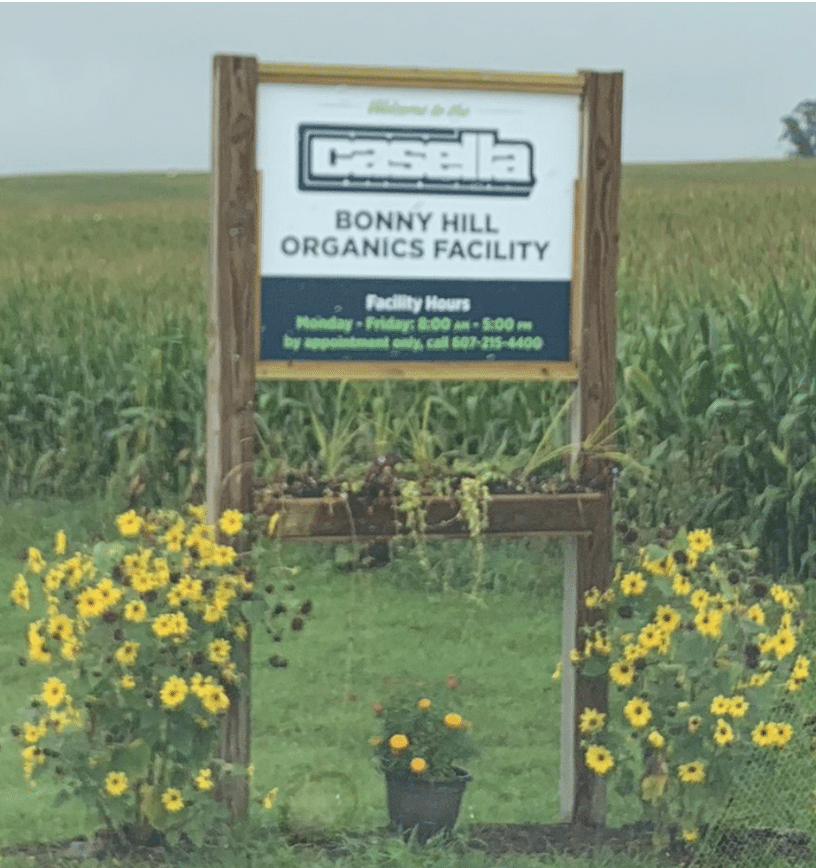
Three of five highest PFAS results, and five of the top 10, came from certified testing by Eurofin Labs. Those samples had been collected by the Sierra Club volunteers, who were instructed to follow a strict collection protocol.
Most of the highest readings—both certified and uncertified—were from sites in the Bonny Hill area, where the Dicksons have been spreading sludge since the 1980s. Spreading in the other two areas began after 2010.
Of the 46 Bonny Hill water samples, 31 came from sites adjacent to sludge-spread fields, while 15 did not. PFAS from the sludge-adjacent sites averaged 15.9 parts per trillion, while PFAS from the non-adjacent sites averaged 1.9 ppt.
The threshold for “safe” levels of PFAS has been dramatically reduced in recent years by state and federal regulators.
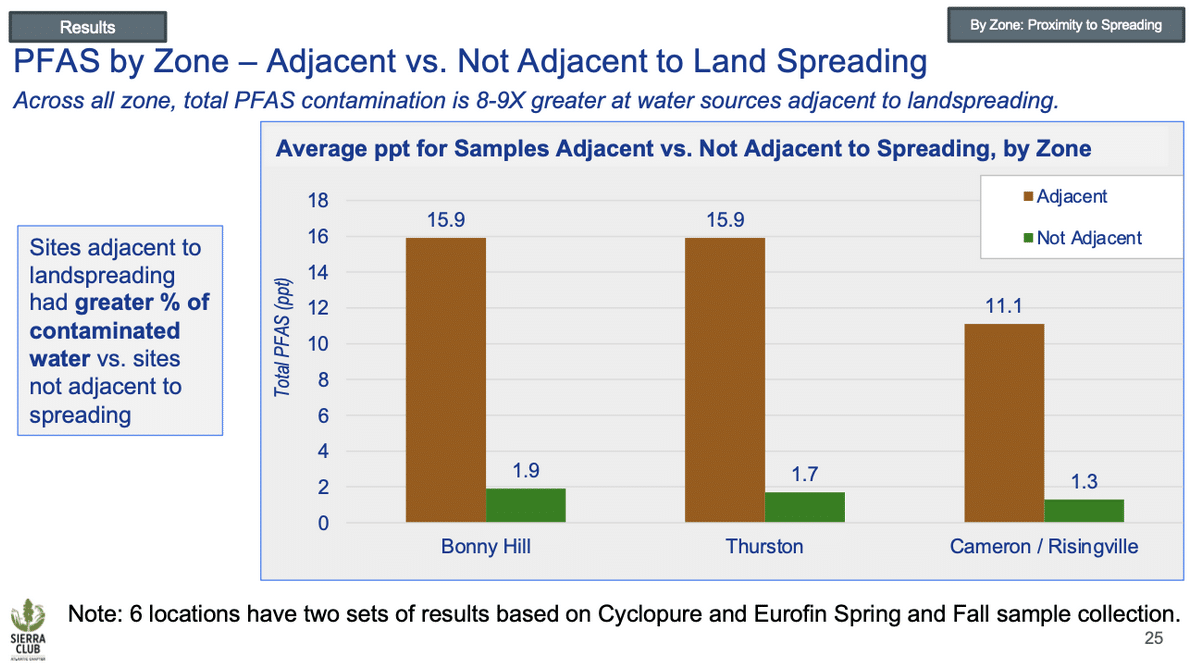
For example, in 2016 the U.S. Environmental Protection Agency set a lifetime health advisory level of 70 parts per trillion for PFOA and PFOS, two of the most common compounds in the PFAS class of chemicals that numbers more than 10,000.
Last year, the EPA cut those advisory levels by thousands of times to 0.004 ppt for PFOA and 0.02 ppt for PFOS. The federal agency has proposed enforceable limits of 4 ppt in public drinking water for both chemicals.
The DEC currently requires public water systems to remediate if PFOA or PFOS exceeds 10 ppt. The agency’s limits for ambient water are 6.7 ppt for PFOA and 2.7 ppt for PFOS.
The public drinking water standards do not apply to any of the 83 samples tested for the Sierra Club because they come from private wells, streams or ponds.
Six of the 16 Sierra Club water samples from streams or ponds had total PFAS of more than 10 ppt. All six were from sites adjacent to sludge-spread fields and four were from Bonny Hill.
After the Sierra Club presented its findings from the first round of uncertified testing in the spring, Casella’s Mary Rayeski and Larry Shilling told local residents that the company, upon request, would pay for certified tests of water from their wells.
The Bonny Hill family that draws from the well that had the highest PFAS total of all 83 Sierra Club samples—82.1 parts per trillion—made such a request and received a certified test through Casella.
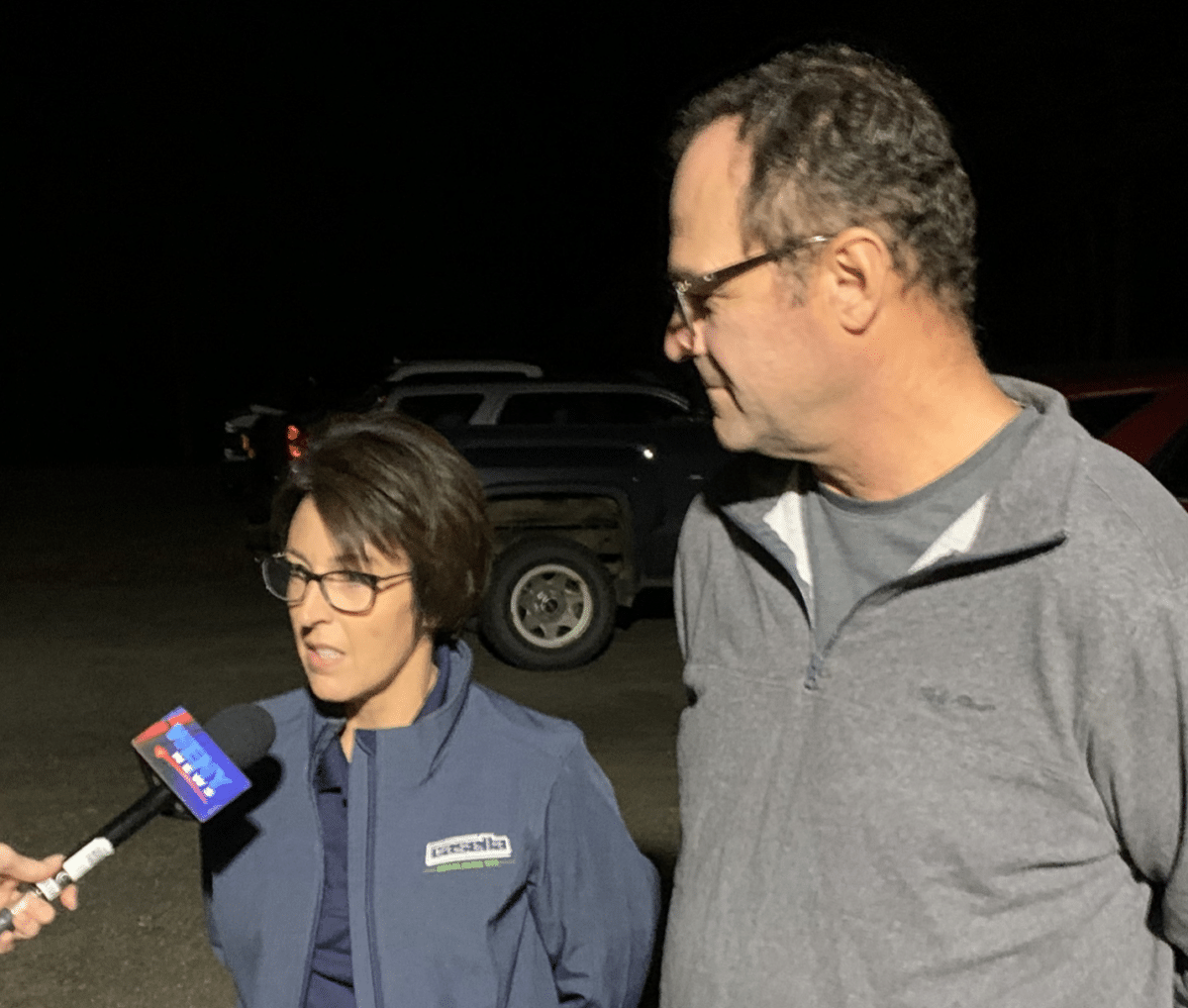
That family told Donderewicz that the PFAS total in the certified test paid for by Casella was even higher than the Sierra Club’s figure. The family, which asked not to be identified, also said Casella had agreed to supply it with potable water, Donderewicz said.
Leslie Smith lives in the Bonny Hill area next to a field the Dicksons have long spread with sewage sludge that he said “stunk so bad.” The Sierra Club provided him with certified water test results for his well and uncertified results for his pond. Both had total PFAS in excess of 10 ppt.
“I was gonna have [Casella] test, but Elizabeth [Donderewicz] came to me and said Sierra Club is going to do a certified one,” Smith said. “So I said, Casella’s going to stay out of here.”
WaterFront asked Rayeski and Shilling to provide data on the results of the certified water tests the company financed for other Steuben residents.
“Our investigation is still ongoing,” Shilling replied in an email. “There are still results we are waiting on and possibly more testing that needs to occur. Also, we do not have permission from all of the individuals to release any of their information so at this time, we cannot comment.”
But Casella has shared detailed data on tests for PFOA and PFOS in soil from fields that have been spread with sludge.
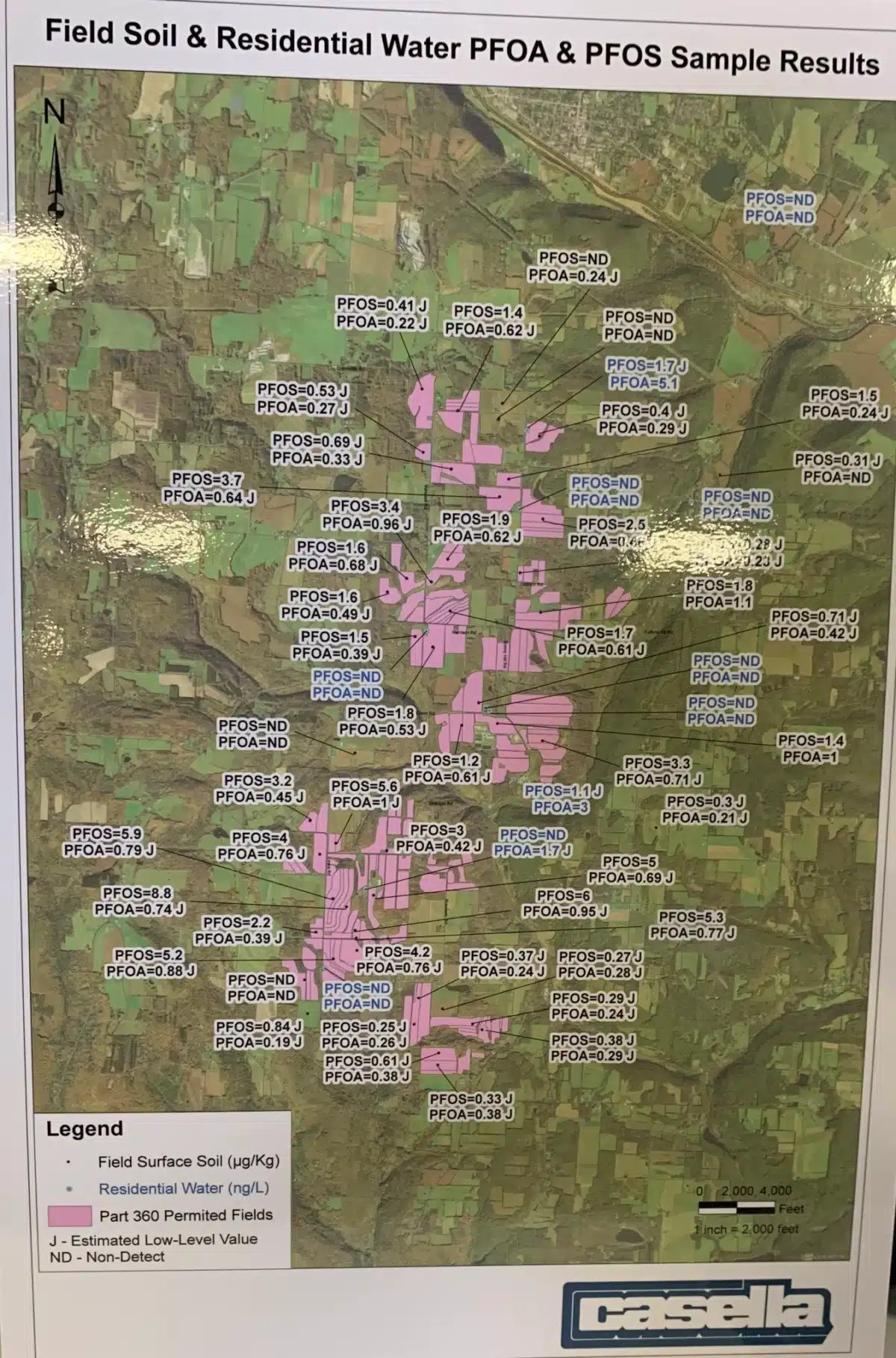
At an open house at its Bonny Hill Organics headquarters in September, the company displayed a map showing PFAS levels in soil from sludge-spread fields. More than 20 sites registered levels of PFOA or PFOS at more than 1,000 ppt (the map showed the results in parts per billion rather than parts per trillion).
According to the map, at least half a dozen fields had PFOS levels above 5,000 ppt, while PFOA results tended to be somewhat lower.
Exposure to PFAS, even extremely in small doses, has been linked to kidney and testicular cancer, changes in liver enzymes, decreased vaccine response, increased cholesterol levels and a host of other health problems.
The compounds are commonly used in everyday non-stick and waterproof household products as well as industrial processes. PFAS chemicals take years to break down and they tend to bioaccumulate in the body.
Donderewicz noted that those who promote the use of sewage sludge as a fertilizer on farm fields often try to minimize the PFAS threat in sludge by arguing that “PFAS is everywhere.”
But the Sierra Club water test results tend to debunk that casual dismissal, she said. They also tend to support the U.S. Department of Agriculture’s conclusion that the soil and hilly topography in Steuben County is far less than ideal for sludge spreading.
The USDA has rated “95.5 percent of land within a seven-mile radius of Bonny Hill … as having ‘very limited’ suitability for land application of municipal sewage sludge,” according to Thurston’s local law banning sludge spreading.
The evidence from the water testing strongly suggests that PFAS from the sludge runs off into streams and migrates into nearby groundwater, she said.

Peter is a career journalist who spent 17 years reporting at the Atlanta Journal-Constitution, which nominated him for the Pulitzer Prize three times. He later edited a pair of business newspaper/websites. He founded the WaterFront blog to report on environmental issues in 2017.
Have thoughts or reactions to this or any other piece that you’d like to share? Send us a note with the Letter to the Editor form.
Want to republish this story? Check out our guide.
More from Barn Raiser

Immigrants Find a Home in This Rural Minnesota Town
